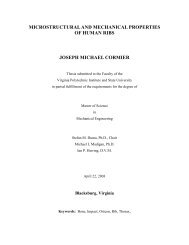Research Articles - VTechWorks - Virginia Tech
Research Articles - VTechWorks - Virginia Tech
Research Articles - VTechWorks - Virginia Tech
You also want an ePaper? Increase the reach of your titles
YUMPU automatically turns print PDFs into web optimized ePapers that Google loves.
<strong>Research</strong> <strong>Articles</strong><br />
Fitzgerald and Anderson on<br />
Lovers, Wives and Mothers<br />
Elizabeth Rose Carraway<br />
Abstract: “Winter Dreams” by F. Scott Fitzgerald and “Mother” by Sherwood<br />
Anderson are two short works that have been surrounded<br />
by criticism because of their enigmatic portrayals of female characters.<br />
Is Judy Jones a shallow seduction symbol? Or is she an<br />
intelligent character using her beauty as a counterpunch to social<br />
conventions? Does Anderson trap women with his nostalgic<br />
optimism or does he give trapped women a voice as characters<br />
advocating intimacy and creative expression? These works<br />
are plagued with the contradictions of artists struggling for truth<br />
within the constraints of a distinct time and place: post-WWI<br />
America. By exploring Fitzgerald’s “Winter Dreams” alongside<br />
Anderson’s “Mother,” I attempt to unearth the complexities<br />
that Fitzgerald and Anderson find in a new kind of female<br />
character while simultaneously examining their biased conclusions<br />
which pigeonhole these characters into female stereotypes.<br />
Key Words:<br />
F. Scott Fitzgerald, Sherwood Anderson, Women in Literature,<br />
Modernist Writing<br />
“‘I will stab him,’ she said aloud. ‘He has chosen<br />
to be the voice of evil and I will kill him.<br />
When I have killed him something will snap<br />
within myself and I will die also. It will be a<br />
release for all of us’” (Anderson 1217). This<br />
passage from Sherwood Anderson’s “Mother”<br />
does not lead to murder, but the woman<br />
speaking has become desperate enough to<br />
contemplate killing her own husband. Elizabeth<br />
Willard has lost her sense of identity, a<br />
dramatic portrayal of how many Americans<br />
felt during the political, social, and economical<br />
upheaval of the early twentieth century.<br />
When the United States entered World War<br />
I in 1917, America was still a largely agricultural,<br />
rural nation (“American Literature<br />
between the Wars” 1071). Americans had<br />
30<br />
to come to terms with irreversible global<br />
modernization and learn to compromise<br />
pre-war ideals with the emerging capitalist<br />
society. The nation was beginning to see a<br />
“New Woman” in Quentin E. Martin’s words,<br />
one that “worked, talked freely and frankly,<br />
and questioned the rules of society” (162).<br />
Mobilized by the Nineteenth Amendment’s<br />
grant of women’s right to vote in 1920, as<br />
well as a growing female presence in the<br />
workforce, women had begun to demand<br />
freedom from sexual double standards<br />
(“American Literature between the Wars,”<br />
1074). Unfortunately, as Martin notes, “this<br />
transformation of women was by no means<br />
complete - it was, in fact, producing profound<br />
complications and problems” (163).



